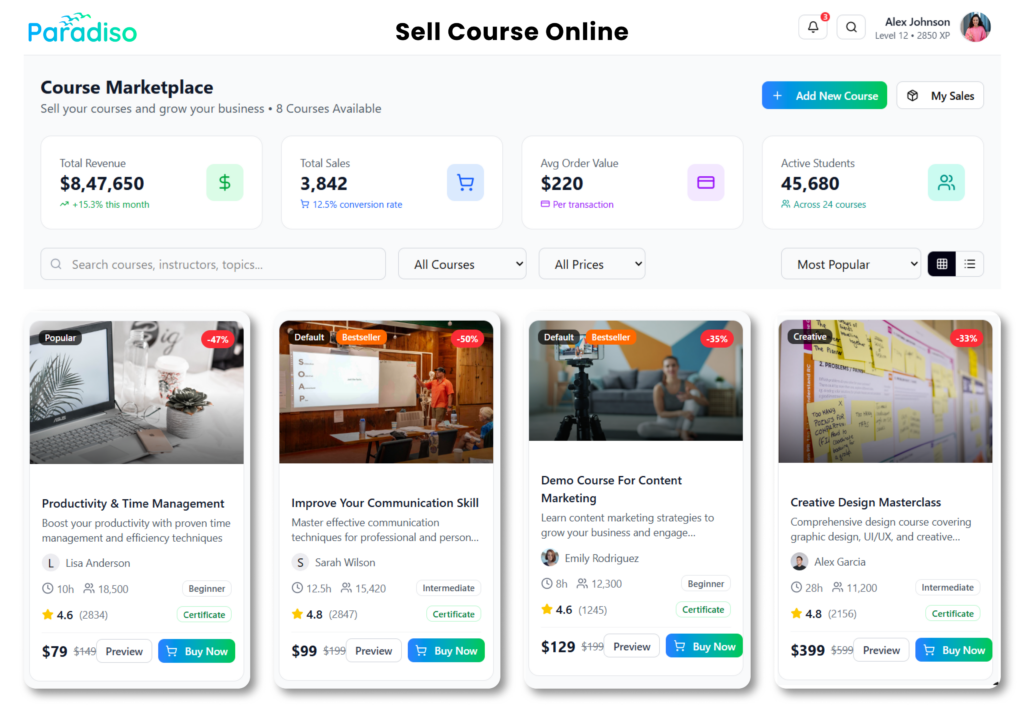So, you’re considering investing in a new LMS but looking for something other than any old system. Instead, you want one packed with core functionality, easy to use, and won’t break the bank. But there are more; you also want to ensure the LMS you choose can play nicely with all the other software systems you’re already using.
This guide will give you the inside scoop on LMS integrations, what they are and how they work, and highlight the most important integrations for any learning business like yours.
LMS stands for “Learning Management System.” A learning management system (LMS), is a tool used to design and deliver educational content, monitor student performance, and manage student participation. It can be accessed through a software application or a web-based platform and is typically used by instructors to facilitate learning.
Examples of LMS include Paradiso, Blackboard, Canvas, and Moodle.
LMS integration refers to connecting an LMS to other systems or software to share data and functionality. This might include integrating the LMS with other educational technologies, such as a virtual classroom tool or a plagiarism checker, or integrating it with other systems used by the institution, such as a student information system or a single sign-on system.
The importance of LMS integration is that it can help to streamline the learning process, make it more efficient, and provide a more seamless experience for both students and instructors. For example, suppose an LMS is integrated with a virtual classroom tool. In that case, it can enable students to access the virtual classroom directly from the LMS, eliminating the need to log in to multiple systems. Similarly, the LMS is integrated with a student information system. In that case, it can allow instructors to access student demographic information, such as their major or class standing, directly from within the LMS without the need to log in to a separate tool or system.
Several essential LMS integrations can significantly enhance the functionality and user experience of an LMS. These include:
1. Single Sign-On (SSO) integration: This allows students and instructors to log in to the LMS using the same credentials they use to access other systems, such as their institution’s email or student information system. This can save users time and reduce the likelihood of login problems.
2. Student Information System (SIS) integration allows instructors to access important student information, such as demographic data and course enrollment, directly from within the LMS. This can save instructors time and improve the accuracy of information.
3. Integration of a Virtual Classroom in an LMS enables students to attend online classes in real-time within the same platform, eliminating the need for multiple system logins.
4. Learning Analytics integration: This allows instructors to track student progress and engagement and to use that data to improve the learning experience. Learning Analytics can allow for
automated tracking of student progress. It can provide insights into students’ engagement and success in the class, allowing them to identify early students who might be struggling.
5. Communication and collaboration tools integration: This allows students to communicate and collaborate with instructors in real-time within the LMS, which can improve the overall class experience and allow students to receive and give feedback more timely.
6. External assessment and evaluation tools integration: This allows instructors to create, deliver, grade assessments and quizzes, and track results directly within the LMS. This can save instructors time and reduce the likelihood of errors.
7. Content Management Systems (CMS) integration: This allows the LMS to connect with an external CMS that holds the content of the class. This can facilitate the instructor’s creation and management of class content, making it easily accessible to the students.













